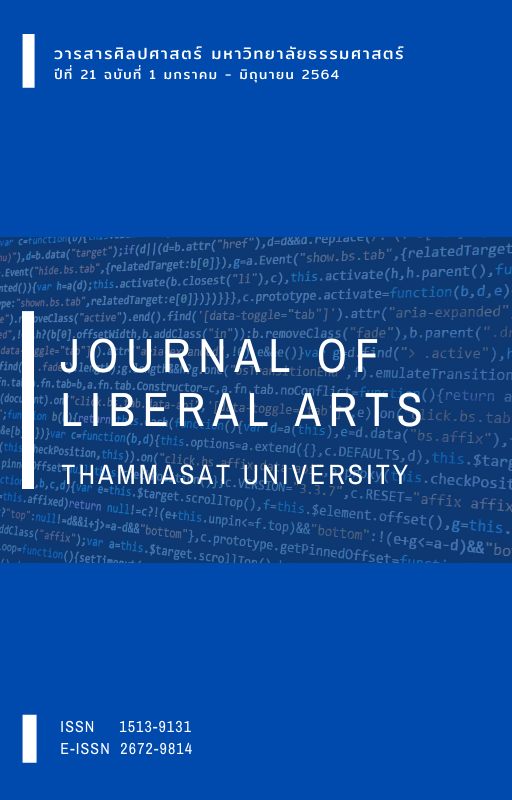กลยุทธ์การสื่อสารของผู้เรียนภาษาญี่ปุ่นชาวไทย: กรณีฟังไม่เข้าใจ
Main Article Content
บทคัดย่อ
งานวิจัยนี้มีวัตถุประสงค์เพื่อศึกษากลยุทธ์การสื่อสารของผู้เรียนภาษาญี่ปุ่นชาวไทย กรณีฟังการสนทนาภาษาญี่ปุ่นไม่ทันหรือไม่เข้าใจ เพื่อเป็นแนวทางพัฒนาทักษะการฟังพูดภาษาญี่ปุ่นของผู้เรียนชาวไทย ผลการศึกษาพบว่าผู้เรียนใช้วิธีการยืนยันการฟังของตนมากที่สุด และพบการขอให้พูดซ้ำเป็นลำดับถัดมา การเลี่ยงด้วยการหัวเราะพบในการสนทนาของผู้เรียนระดับต้นและกลาง ขณะที่การขอโทษพบในการสนทนาของผู้เรียนระดับ กลาง แม้ผู้เรียนระดับต้นและกลางพยายามสื่อสารกับชาวญี่ปุ่นอย่างสุภาพ อย่างไรก็ดี เมื่อพิจารณาจากมุมมองความสุภาพ ยังไม่อาจกล่าวได้ว่าผู้เรียนสามารถสื่อสารภาษาญี่ปุ่นอย่างสุภาพได้เหมาะสมและมีประสิทธิภาพในสถานการณ์เหล่านี้
Downloads
Article Details

อนุญาตภายใต้เงื่อนไข Creative Commons Attribution-NonCommercial-NoDerivatives 4.0 International License.
เอกสารอ้างอิง
กนกวรรณ เลาหบูรณะกิจ คะตะกิริ. (2555). กรอบมาตรฐานภาษาญี่ปุ่น (Japanese Language Standard) ด้านการพูดและการฟังสำหรับผู้เรียนภาษาญี่ปุ่นเป็นวิชาเอก ในสถาบัน อุดมศึกษา: กรณีศึกษาของจุฬาลงกรณ์มหาวิทยาลัย. วารสารอักษรศาสตร์, 41(1), 1-35.
สุณีย์รัตน์ เนียรเจริญสุข, พัชราพร แก้วกฤษฎางค์, และเผ่าสถาพร ดวงแก้ว. (2554). โครงการพัฒนาทักษะการฟังพูดภาษาญี่ปุ่นโดยใช้โปรแกรมสไกป์: การสำรวจความคิดเห็นและการประเมินตนเองของนักศึกษาที่เข้าร่วมโครงการ. วารสารญี่ปุ่นศึกษา, 34(2), 38-54.
American Council on the Teaching of Foreign Languages. (2012). ACTFL Proficiency Guidelines 2012. Retrieved 2 December 2015, from https://www.actfl.org/sites/default/files/pdfs/public/ACTFLProficiencyGuidelines2012_FINAL.pdf
Bachman, L. F., & Palmer, A. S. (1996). Language testing in practice. Oxford: Oxford University Press.
Brown, P., & Levinson, S. (1987). Politeness: Some Universals in Language Usage. Cambridge University Press.
Chiba, M., & Yomnak, V. (2015). Saiamu daigaku kyouyou gakubu nihongo komyunikeeshon gakka no kaiwa shukyouzai no sakusei houshin, nagare oyobi naiyou. Nihongo kyouiku kiyou, The Japan Foundation, Bangkok, 12, 37-46.
Choi, H. (2011). Nihonjin to kankokujin no aizuchi hikaku-aizuchi no hindo, taimingu, kinou nitsuite. Nihon joshi daigaku kokugo kokubun gakkai kokubun mejiro, 50, 100-113.
Coates, J. (2007). Talk in a play frame: More on laughter and intimacy. Journal of Pragmatics, 39, 29-49.
Council of Europe. (2001). Common European Framework of Reference for Languages: Leaning, teaching, assessment. Cambridge: Cambridge University Press. Retrieved 20 May 2017, from https://rm.coe.int/1680459f97
Faerch, C., & Kasper, G. (1983). Plans and strategies in foreign language communication. In C. Faerch, & G. Kasper (Eds.), Strategies in Interlanguage Communication, pp. 20-60, London: Longman.
Holmes, J. (2006). Sharing a laugh: Pragmatic aspects of humor and gender in the workplace. Journal of Pragmatics, 38, 26-50.
Hymes, D. H. (1972). On Communication Competence. In Pride, J. B. and Holmes, J. (Eds.), Sociolinguistics Selected Readings, pp. 269-293, Harmondsworth: Penguin Books.
Ikegami, Y. (2009). “Ninchigengogaku” kara “nihongo rashii nihongo” e mukete. In Y. Ikegami, & M. Moriya (Eds.), Shizenna nihongo wo oshieru tameni-ninchigengogaku wo fumaete, pp. 2-40, Tokyo: Hituzi Syobo.
Iori, I., Hidaka, M., Maeda, N., Yamada, T., & Yamato, S. (2003). Yasashii nihongo no shikumi. Tokyo: Kuroshio Publishers.
Kabaya, H., Kim, D., & Takagi, M. (2009). Keigo hyougen handobukku. Tokyo: Taishukan Publishing.
Kitaguchi, N., Yamaguchi, Y., & Yoshida, N. (2012). Trends in CEFR and Evaluation Standards of Japanese Language Education- An Attempt to Create TU Standards at Thammasat University. Japanese Studies Journal, 29(1), 97-108.
Koizumi, T. (2001). Nyuumon goyouron kenkyuu-riron to ouyou. Tokyo: Kenkyusha.
Leech, G. N. (1983). Principles of Pragmatics. London: Longman.
Machida, K. (2004). Shiriizu-nihongo no shikumi wo saguru 6 nihongo goyouron no shikumi. Tokyo: Kenkyusha.
Makita, M. (2014). Listening Strategies and Cues; An Analysis of Three Groups: Intermediate Learners, Advanced Learners, and Native Japanese Speakers. Journal of the Phonetic Society of Japan, 18(1), 1-12.
Nariyama, S. (2009). Nihongo no shouryaku ga wakaru hon-darega? dareni? naniwo?. Tokyo: Meiji Shoin.
Ozaki, A. (1989). Requests for clarification in conversation between Japanese and non-Japanese. Canberra: The Australian National University.
Ozaki, A., & Tsubaki, Y. (2001). Denwakaiwa ni okeru shokyuu nihongo gakushuusha no “kikikaeshi” to “kikikaeshi” kaihi. Nihongo nihonbunka ronshuu, 9, 25-45.
Spencer-Oatley, H., & Franklin, P. (2009). Intercultural interaction: A multidisciplinary approach to intercultural communication. New York: Palgrave Macmillan.
Suda, M. (2010). Yasashii nihongo shidou 13 gengo to komyunikeeshon. Tokyo: Bonjinsha.
Takiura, M. (2008). Poraitonesu nyuumon. Tokyo: Kenkyusha.
Tanaka, H., & Tanaka, S. (1996). Shakaigengogaku e no shoutai-shakai, bunka, komyunikeeshon. Kyoto: Minerva Shobo.
The Japan Foundation. (2010). JF Standard for Japanese-Language Education 2010. Retrieved 25 April 2016, from https://jfstandard.jp/pdf/jfs2010_all_en.pdf
Tsubaki, Y. (2010). Training in Clarification Requests as a Communication Strategy: Toward Effective Use in Real Situations. Japanese Language Education, (147), 97-111.
Usami, M. (2015). Basic Transcription System for Japanese: BTSJ 2015. Retrieved 25 April 2018, from http://ninjal-usamilab.info/pdf/btsj2015.pdf. [in Japanese]
Wittayapanyanon, S., & Higuchi, K. (2012). Nihonjin no fushigi communication. Tokyo: Shodensha Publishing.
Yamaoka, M., Makihara, T., & Ono, M. (2010). Komyunikeeshon to hairyo hyougen-nihongo goyouron nyuumon. Tokyo: Meiji Shoin.


